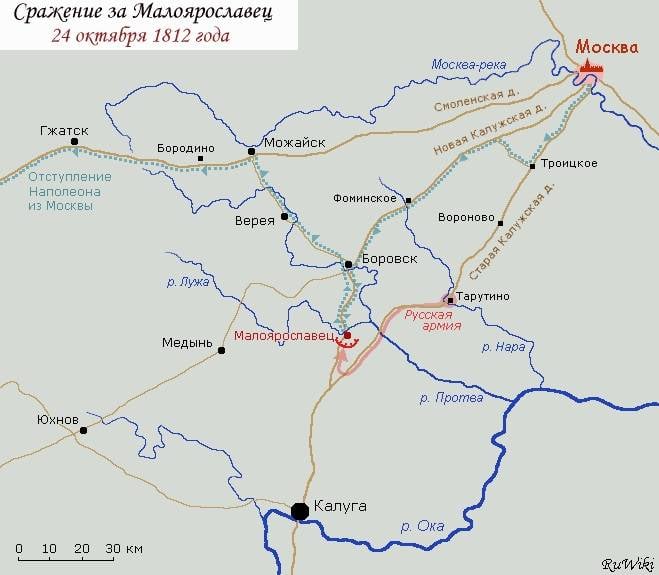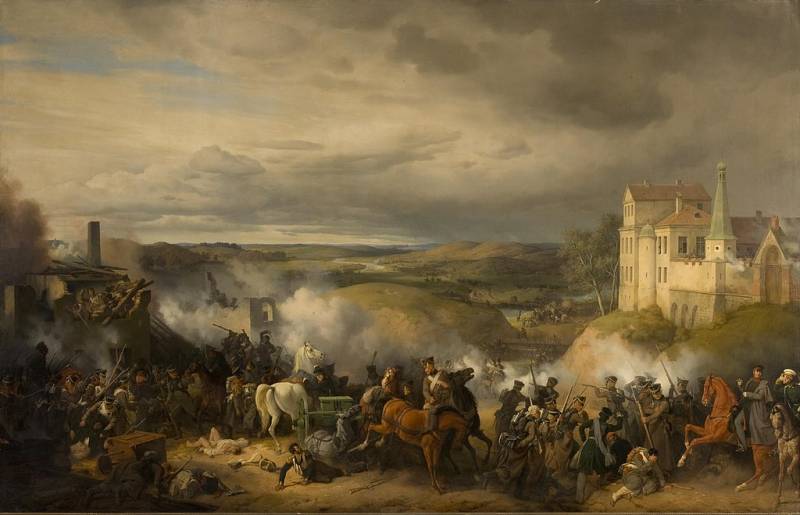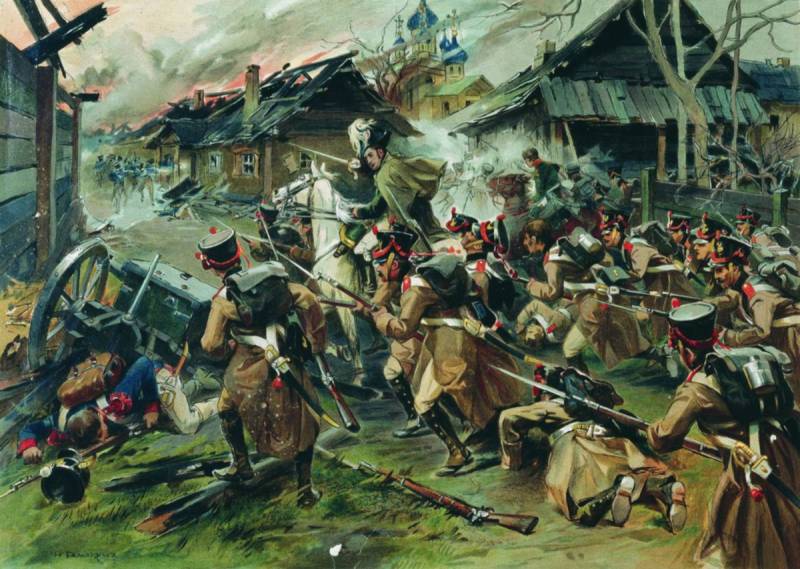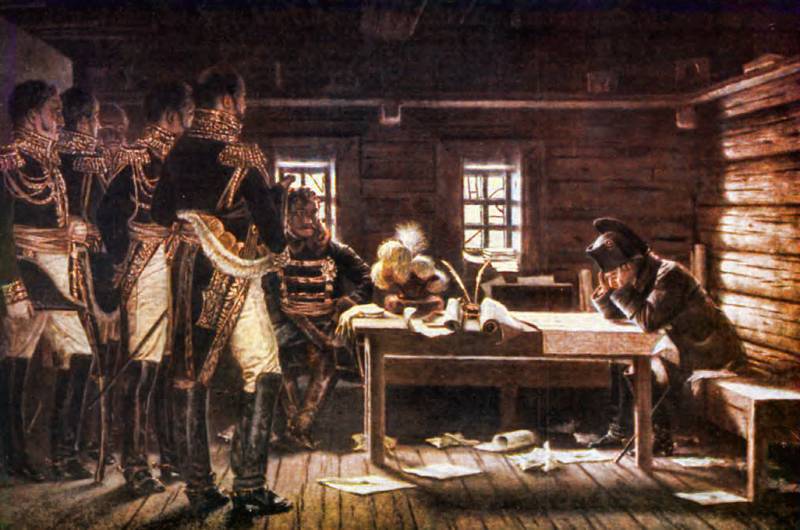Furious battle for Maloyaroslavets. Napoleon won the battle but lost the campaign

A. Yu. Averyanov. Battle for Maloyaroslavets
General situation
Napoleon Bonaparte, having lost hope of making peace with Alexander I, decided to leave Moscow and withdraw the army to the west. However, he did not want to lead troops across the devastated, plundered land, where the war had already swept. On October 1 (13), 1812, Napoleon held reviews of the troops. All the wounded were sent to Smolensk. Prepared a supply of provisions for 20 days. This stock should have been enough to Smolensk. The situation with fodder was worse, although the number of horsemen of the Great Army was greatly reduced. It remains only to finally choose the road to Smolensk. Three roads led to the west. The first through Mozhaisk to Smolensk; the second - north of the Smolensk road, through Volokolamsk, Zubov and Vitebsk; the third road went through Vereya, Yelnya and stretched to Smolensk.
The first road was the shortest and best known. However, the area here was devastated, and movement through it gave the impression of flight. The emperor wanted to maintain the appearance that he was not retreating, but was carrying out a retreat maneuver to winter quarters in order to continue the campaign in 1813. The second road was more convenient, but subject to the preparation of stores. Also, the movement in the north-western direction created a threat to St. Petersburg. But in this case, Russian troops remained in the rear, so most of the commanders opposed this plan.
There was a third road, near which Russian shops were located. Their capture solved the problem of providing the army with food, weapons and ammunition, and put the Russians in a difficult position, depriving them of supply bases. Leaving Moscow, Napoleon wanted to hide his maneuver. It was believed that the Great Army was leaving Moscow for an offensive operation in order to capture Tula, Kaluga and Bryansk, where the main reserves of the Russian army were concentrated. An 8-strong detachment was left in Moscow under the command of Marshal Mortier. It included one division of the Young Guard, reinforced by other units. Also, each corps left a detachment, which covered the approaches to the city.
Mortier was ordered to mine the Kremlin and destroy it when leaving. True, the French themselves did not believe the official version. Therefore, the soldiers of the Great Army tried to take with them as much loot as possible. The army, overloaded with various junk, completely lost its mobility. However, Napoleon could not order the troops to abandon the trophies, as discipline had sunk badly, and the soldiers could mutiny. The emperor himself promised the troops all the treasures of the Russian capital and carried with him a large "gold convoy".
Thus, Napoleon was going to lead the army to the lands still unaffected by battles, lying to the south-west of Moscow. The corps planned to withdraw from Moscow along the Old Kaluga road, and then go to the New Kaluga road and move through Borovsk and Maloyaroslavets to Kaluga. The French wanted to seize the large stores (warehouses) located there with provisions collected for the Russian troops. From Kaluga, the French were to turn west. Bonaparte tried to hide this maneuver from the Russians so that Kutuzov would stay in Tarutino as long as possible and not interfere with the French.

Exodus of the French from Moscow
On October 7 (19), 1812, the French army (110 thousand) with a huge convoy began to leave Moscow along the Old Kaluga road. In the forefront were the 4th Infantry and 3rd Cavalry Corps of the Great Army. The commander of this vanguard was the Italian viceroy, Prince Eugene de Beauharnais, the stepson of the French emperor. On October 9 (21) the French advanced forces arrived in the village of Fominskoye, and from there on October 10 (22) they went to the village of Kotovo. Behind the vanguard of the Italian Viceroy was Ney's 3rd Infantry Corps, Davout's 1st Corps and the Old Guard. Behind them came the Young Guard and Colbert's guard cavalry.
Napoleon did not want a new general battle, he sought to bypass the Russian army along the New Kaluga road in order to reach Maloyaroslavets, then Kaluga and, possibly, Tula, after turning to the Smolensk road. But the success of the operation depended on stealth and speed. And that was a big problem. Firstly, Russian partisans and Cossacks constantly watched the enemy, reported to the command about his movements.
Secondly, the army's horse park could not be restored, so large cavalry formations almost disappeared, the guards cavalry numbered only 4,6 thousand horsemen, artillery had to be significantly reduced. The cavalry played a major role in such operations - reconnaissance, covering the infantry, demonstrating false attacks. In fact, without cavalry, the march to Kaluga from the very beginning had no chance of success, it remained only to hope for the complete inaction of the Russians.
Thirdly, the French army was slowed down by huge carts. These were columns of robbers and marauders, not warriors. The army has lost mobility, maneuverability.
Obviously, the experienced commander Napoleon understood this well. But he decided on this operation, apparently hoping for the mistakes of the enemy. Ney's corps was sent from Troitsky to Voronov, and the main forces turned from Krasnaya Pakhra to Fominsky. The French headquarters remained in Fominsky. From there, Napoleon ordered the chief of staff, Berthier, to send Colonel Bertemi to Tarutino on October 8 (20) with a letter to Kutuzov. In it, Bonaparte suggested that the Russian commander abandon the methods of "small war" and give the war "a course consistent with the established rules." The main goal of Bertemi was reconnaissance: to make sure that the Russian army was in the Tarutino position and to misinform the Russians, to show that the French army was still in Moscow.
Kutuzov replied that
Having learned from Bertemi that the Russians were still in position at Tarutino, Bonaparte hurried. The main forces were sent to Borovsk, Poniatowski's corps - to Vereya. Marshal Mortier was ordered to blow up the Kremlin and public buildings in Moscow and go to Vereya. Junot, who was stationed in Mozhaisk with the remnants of the 8th Westphalian Corps, was to begin preparations for the movement to Vyazma. Part of the reserve 9th corps of Victor advanced to Yelna in order to provide communication with the main forces of the army.
Mortier's detachment left Moscow on the night of 8 (20) to 9 (21) October 1812. The French were able to blow up several towers in the Kremlin, destroy the arsenal, the palace and the Palace of Facets burned down. Cathedrals were badly damaged. Most of the mines did not explode, the fires stopped, as it was raining heavily. Napoleon stated:
On October 11 (23), Berthier ordered the troops to speed up the march in order to forestall Kutuzov's forces at Maloyaroslavets. That is, Bonaparte was not looking for a general battle, on the contrary, he tried to break away from the Russian army and pretended that everything was fine.

Peter von Hess. Battle of Maloyaroslavets
Kutuzov's plans and actions
The Russian commander-in-chief Kutuzov believed that the enemy would soon begin to retreat to the west. The French were preparing large stores in Smolensk and Vilna, there were also reserve buildings here. After the Battle of Tarutino (Defeat of Murat in the Battle of Tarutino) the Russian army was preparing to go on the offensive. The commanders of the army partisan detachments were given two options for action in case the enemy tries to give a new general battle at Tarutino, or starts a retreat. Under the first option, the partisans were supposed to conduct reconnaissance, threaten the enemy from the flanks and rear; in the second - to try to preempt the enemy on the march, using the tactics of "scorched earth", destroying food and fodder along the way of the French.
The partisan detachments reported on the movements of the enemy, so the Russian command guessed the plan of the French in time and took retaliatory measures. So, Seslavin's detachment, which operated between the Kaluga and Smolensk roads, discovered the appearance of the enemy on the New Kaluga road. On October 4 (16), Seslavin went to Fominsky and established contact with Dorokhov's detachment. Dorokhov's detachment was in the Kiselevka-Kamensky area when he received news of the appearance of the French in the village of Maltsevo. Connecting with Figner's detachment, Dorokhov attacked the enemy at Maltsev, but was forced to retreat under the onslaught of superior forces. Seslavin informed Dorokhov that the French had occupied Fominsky with large forces.
At the beginning, Dorokhov suggested that this was a large detachment of foragers and asked Konovnitsyn for two regiments of infantry to hit the enemy. Having received reinforcements, Dorokhov again attacked at Maltsev. The attack on Fominsky had to be abandoned and withdrawn when it became clear that two enemy divisions were stationed there.
On the night of October 8-9 (20-21) Dorokhov informed Konovnitsyn about the concentration of French troops near Fominsky. He suggested that these troops were put forward to cover the road from Moscow to Voronovo, Fominsky, Ozhigovo and Mozhaisk, or that they were the vanguard of the entire enemy army that was marching on Borovsk. Dorokhov's report was also confirmed by other news received at that time.

A. Yu. Averyanov. Battle for Maloyaroslavets
Kutuzov sent Dokhturov's 6th Infantry Corps, Meller-Zakomelsky's 1st Cavalry Corps, and Platov's six Cossack regiments to Fominsky. Dokhturov was supposed to attack the enemy in Fominsky. On October 10 (22), Dokhturov's forces joined forces with Dorokhov's detachment in Aristovo. Soon Dokhturov received a report from Seslavin that the main forces of the French army were heading towards Fominsky. The general informed Kutuzov that the troops of Ney's corps and the Old Guard were stationed near Fominsky. The Governor-General of Kaluga informed Kutuzov that the French units had entered Borovsk. Then Miloradovich, who was watching the forces of Murat, reported that the troops of the Neapolitan king were retreating from Voronovo to Borovsk.
It became clear that the enemy army was going through Borovsk and Maloyaroslavets to Kaluga. Kutuzov ordered Dokhturov to advance towards Maloyaroslavets. Preparations began for crossings and roads leading from Tarutino to Maloyaroslavets. Miloradovich received an order to continue to monitor Voronov, and then retreat to Tarutino in order to protect the rear of the army during its maneuver.
The Russian army advanced towards Maloyaroslavets in two columns. The first column under the command of Borozdin included the 7th and 8th infantry corps, the 2nd cuirassier division. The second column of Lavrov included the 3rd and 5th infantry corps, the 1st cuirassier division. Even earlier, Platov’s corps was sent from the vanguard of Miloradovich to Maloyaroslavets, he had the task of advancing to the Borovsk road and, together with Dokhturov’s forces, covering Maloyaroslavets from the north.

Bits
The march of Dokhturov's troops took place in difficult conditions: heavy rains washed out roads, crossings were damaged. On the evening of 11 (23) October, Dokhturov's troops in the village of Spasskoye united with Platov's Cossacks. Dokhturov's forces reached Maloyaroslavets only on the night of October 12 (24). Then it turned out that the city was occupied by the enemy. These were two battalions from the division of General Alexis Delzon.
Seeing that the enemy was small in number, Dokhturov attacked. Our rangers (two regiments) drove out the French. But at dawn, Delzon led a brigade of the 13th division to attack. Dokhturov sent another jaeger regiment into battle. The soldier was led by Yermolov, who was with the 6th Corps. Our troops again drove the enemy out of the city. The remaining troops of the 6th Corps occupied the heights and closed the road to Kaluga. The cavalry and Dokhturov's detachment closed the road to Spasskoye. Artillery was brought into two large batteries, which were located in front of two buildings.
Delzon again went on the attack, throwing the entire division into battle. A fierce battle broke out again. The brave French divisional general was in front of his soldiers. During a skirmish in the city cemetery, the brave general, dragging forward his warriors, who lingered under heavy fire from the enemy, received three bullet wounds, one of which (in the forehead) turned out to be fatal. His adjutant, Baptiste Delzon, who rushed to his older brother, shared his fate.

A. Yu. Averyanov. Divisional General A. Zh. Delzon in the battle for Maloyaroslavets
The 13th division was led by General Guillemino, who gave the order to capture the hill dominating the western part of the city. At 11 o'clock the battle took on an even more violent character, Beauharnais threw Brusier's division into the fire of the battle. By noon, about 9 thousand Frenchmen (13th and 14th divisions) and 9 thousand Russian soldiers were fighting in Maloyaroslavets. The French fought bravely and energetically, they again occupied the city and even attacked parts of our corps that were on the heights. The attack of the French infantry, undertaken without artillery support, was repulsed by cannon fire and a bayonet strike. Then the Russian units again recaptured Maloyaroslavets.
By 2 o'clock in the afternoon, the viceroy threw into battle the 15th Pino division and parts of the guard. The French captured the city and began to attack the positions of Dokhturov's corps. Our troops with difficulty held back the strong onslaught of the enemy. At this time, the 7th corps of Raevsky (10,5 thousand people with 72 guns) approached and took up a position between the 6th infantry and 1st cavalry corps. The number of Russian troops at Maloyaroslavets grew to 22 thousand soldiers with 144 guns. Our troops went on the attack again and recaptured the city for the fifth time. Maloyaroslavets was heavily destroyed and burned.
The Frenchman Labom describes the city after the battle:
The French brought the units of Davout's 1st corps into battle. The French once again captured the city and attacked our positions on the heights. The factor that played in favor of our army was that numerous enemy artillery (up to 300 guns) got stuck at the crossings and on the northern outskirts of the city, not taking part in the battle. Russian troops shot the attacking ranks of the enemy with grapeshot almost point-blank, then went with bayonets. Our troops recaptured the southern part of the city.
Two more enemy divisions approached, led by the emperor himself. Fresh units went on the assault and captured the city again. The thinned and weary troops of Dokhturov and Raevsky withdrew and fortified themselves on the heights. At 4 o'clock in the afternoon, the main forces of Kutuzov went to the battlefield. Our troops bypassed the city from the south and took up a position 1–3 km from Maloyaroslavets, blocking the path to Kaluga. The depleted 6th Corps was replaced by the 8th. Our troops attacked again.
As a result, the city changed hands 8 times. By the end of the day, the situation was as stable as before the battle: the French had the city, and the Russian troops on the heights to the south were blocking the way to Kaluga. Maloyaroslavets is almost completely destroyed. The Russian army lost about 3 thousand killed and wounded (according to other sources, about 6 thousand people). The French lost about 5 thousand people.

N. S. Samokish. Battle for Maly Yaroslavets
Results
On October 13 (25), 1812, the two armies stood in their positions and prepared for a new battle. Kutuzov was ready to give a pitched battle. So that the enemy would not bypass him, he sent Platov's regiments to Vereya, he was reinforced by the detachments of Davydov and Shevelev. The Cossacks raided the enemy camp in the early morning, captured 11 guns and almost captured the emperor himself. Miloradovich had to go west.
Bonaparte held a council in the city. The militant Murat offered to lead the guards and the remnants of the cavalry and break the way to Kaluga. The opinions of other commanders were divided. Napoleon decided to retreat:
The French emperor knew the position of his army well: he had about 70 thousand people, the Russians had more, the French were much inferior in artillery - 360 guns against 700 Russians, and ammunition was left for one big battle. There were practically no cavalry. Therefore, attacking the strong positions of the Russians, as at Borodino, was dangerous.
On October 14 (26), 1812, the French army received an order to leave for Borovsk - Vereya - Mozhaisk. Thus, the tactical victory in the battle for Maloyaroslavets was won by the French, and the strategic one by the Russians. The French army had to abandon the campaign against Kaluga and leave along the Smolensk road. The Russian army seizes the strategic initiative in the war and goes on the offensive, pursuing the enemy.

Napoleon at the council after Maloyaroslavets. Artist V. Vereshchagin: “In Gorodnya - to break through or retreat?”
Information